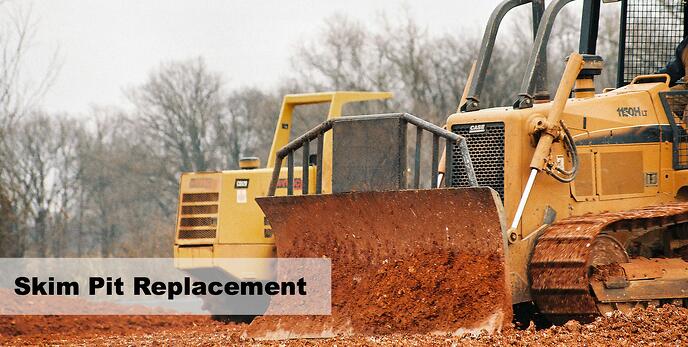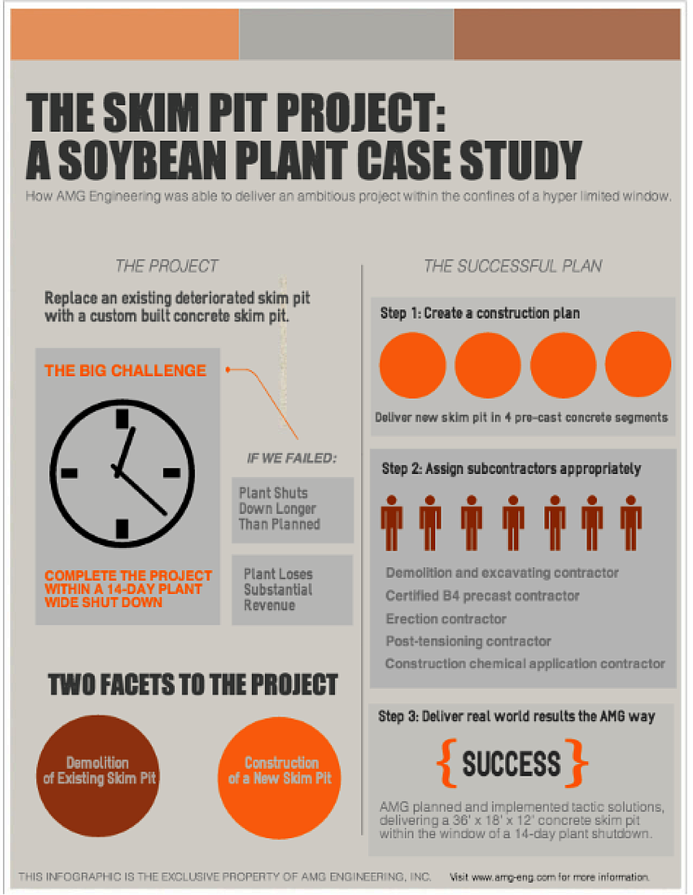Every project faces it’s own set of obstacles and challenges.
Recently, AMG was tasked with replacing a severely deteriorating skim pit for a soybean facility within the confines of a 14-day facility shutdown. If we were unable to deliver the final project in that short window, the facility would begin losing money hand and fist for each additional day the plant was shut down. Here’s a step-by-step overview of how AMG worked a solution despite the myriad of challenges both before and during the project.
Step 1: Get familiar with the former skim pit.
A skim pit is an object that separates hexane, or a soybean oil and hexane mixture, from water. Typically, a structure like this stands in ground and is lined by concrete, while water with minute amounts of oil is pumped inside its depths. At this particular facility, the skim pit was a massive cast-in-place structure, severely deteriorated by years of use. The facility faced a critical need to build a new pit fit suited for the demand of production.
This project would require two basic components: the removal of the old skim pit (as it was located where the new pit would need to be placed), and the placing of a new skim pit ready for production.
Step 2: Line out the challenges for the project.
This was an aggressive project for sure – with the facility setting a 14-day shutdown to make room for the demolition and construction. Beyond the short window, the following challenges threatened the project:
- The combined efforts of several vendors and contractors would require a very deliberate and precise construction plan to keep the project on task.
- The new skim pit was selected by the client, and would need to be disassembled for shipping and reconstructed on site. This would require contractors with very specific certifications and hoisting equipment.
- The original demolition grade was required to extend a couple of feet beyond its original plan. The result would be a higher surface (only a couple of inches) that would drastically affect the mating of two components on the skim pit.
Step 3: Develop a plan for the new skim pit.
In addition to the basic replacement, engineers had to find a way to make the new skim pit more resistant to the fatty acids found in soybean oil. With a customer design already in mind, the decision was made to build the new skim pit by using a segmental, precast concrete pit. The new pit would need to be:
- Cast by a B4 certified precast fabricator in 4 segments - none of which could exceed 9’ in width or 100,000 pounds in weight in order to facilitate shipping
- Shipped to the plant during the shut down and assembled on location
- Drawn together and locked into place using 24 post tensioning strands
- Sealed to be water tight by pressure injection of urethane foam
Step 4: Establish the marching orders.
With both demolition and construction plans firmly in place, and a project budget assembled, it was time to assign roles to qualified subcontractors and set the marching orders into place. Under the direction of AMG, the following assignments were lined out:
- A demolition and excavating contractor was secured to remove the old skim pit and excavate the ground in preparation for the placement of the new pit.
- A certified B4 precast contractor was found and given the direction to cast and ship the segments of the new skim it.
- An erection contractor was tasked with lifting the concrete skim pit segments from the shipping trailer and placing them in their proper location.
- A post-tensioning contractor was given the responsibility of inserting the pre-stressing tendons and drawing the segments together. This contractor would also be tasked with injecting cement grout into the tendon conduits to permanently secure them in place.
- A construction chemicals application contractor was selected to inject the urethane sealant and apply the reinforced urethane liner to the interior of the new skim pit.
Step 5: Adapt to challenges during construction.
Just like any other job, nothing ever happens flawlessly. We were faced with several obstacles along the way but were able to overcome them and deliver the end result just as the client requested. Some of the hurdles we had to overcome were:
- A local contractor was disqualified due to lack of proper PCI certification nor the in-house hoisting equipment. We were able to find a certified and equipped contractor to deliver the job.
- Excavation had to be extended a couple of feet after the major portion of final grading excavation had been completed. The finished grade in the extended area did not sit level with the other segments, causing an issue with aligning two segments of the pre-cast. With some jacking and shimming, the problem was resolved and the project completed on time.
Step 6: Deliver real world results.
Despite facing complicated obstacles, AMG planned and implemented tactful solutions. The team successfully delivered the skim pit in the 4 segments, with dimensions of 36’ by 18’ by 12’ with the overflow baffles included. Hence, the proposed tasks were effectively completed on time, while satisfying all of the specifications and customer preferences.
No matter what the project, AMG is dedicated to working through and finding a solution that will provide our clients with exactly what they request. The soybean skim pit project is just one instance of AMG’s ability to deliver proven solutions to our clients.



